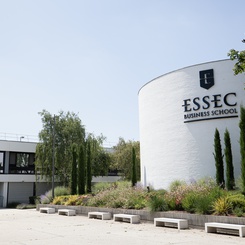Scientific integrity has been a hot topic over the last few years, driven by increasing awareness of the scientific profession and new public norms all over the world. The renewed interest for scientific integrity applies to “hard” sciences and to social science, including research in economics and management – a key activity at business schools like ESSEC.
Radu Vranceanu, Professor of Economics at ESSEC and the ESSEC Referent for Research Integrity (RIS), explains why scientific integrity is so important.
In general, researchers are motivated by some quest for the common good. Many have sacrificed a higher income in a down-to-earth job, for a job with ‘a higher purpose’: a search to find the truth and use it to improve the human condition. Despite this, misconduct can and does still occur: research misconduct has generally been defined as fabrication, falsification, and plagiarism (by the NSF, cf. Schachman, 1993). And there is no doubt about it: scholars bear full individual responsibility for any misconduct.
However, there is a role for the work organization to ensure that a culture of cheating cannot proliferate. Today scholars are playing a research publication game, which has both positive and negative incentives. Bibliometric measures like publications and citations are the new norm in assessing performance, fostering a “publish or perish” culture where researchers are incentivized to publish frequently to obtain tenure and grants. Many would agree with Mejlgaard et al. (2020), who pointed out that deceptive professional behavior is enhanced by “hyper-competitiveness and poor training, the unquestioning and inept reliance on metrics in evaluation, systematic biases in peer review and publication”. In particular, the pressure placed on PhD students and untenured professors contributes to desperation that can lead to unethical professional behavior.
Notorious cases of misconduct in social sciences include Diederik Stapel, a social psychologist who fabricated more than 50 studies, and Eric Poehlman, a University of Vermont medical scientist who published 10 reports containing fabricated patients and data (Gross, 2016; Hall and Martin, 2019). Another psychologist, Dan Ariely, author of an influential book “The Honest Truth About Dishonesty”, provided evidence of a nudge effect in a 2012 paper. Recently, a group of vigilant researchers uncovered evidence that the study’s conclusion relied on fabricated data, though the perpetrator is not clear (The Economist, 2021).
While these forms of serious misconduct can be detected and sanctioned without remorse, what about the lighter forms? This includes behaviors like HARK-ing, or coming up with the hypothesis to test after running the analyses and being aware of the results (Kerr, 1998). To avoid this form of misconduct, several fields now encourage researchers to pre-register their study design with a public repository before undertaking data collection and analysis. On the other hand, serendipity can be an ingredient to breakthrough innovation, thus scholars should be allowed to report any unexpected yet rigorous result.
Journals and editors are clearly biased in favor of positive results. This leads to the phenomenon called the “file drawer effect” (Rosenthal, 1979), where rigorous but negative results go unpublished and languish away in the metaphorical file drawer. So what do we do about the scholar who will “forget” to include their negative results in favor of writing what the editor wants to hear? What about that editor? Neglecting to publish negative results is another form of misconduct, entailing overlapping studies and missing pieces in our understanding of how the world works.
Because editors demand positive results, some scholars might “torture the data” to obtain statistically significant coefficients. One might drop outliers without justification, or choose the time span that minimizes the p-value (used to grasp statistical significance), etc. Brodeur et al. (2022) conducted a meta-analysis of 1030 publications using M-Turk data and found that the statistical distribution of z-statistics has an abnormal high density around 2 (the threshold for statistical significance),while it should be smooth; this suggests a strong p-hacking behavior, hard to detect in individual studies.
An excellent taxonomy of research misconduct in business school research, including many examples of serious and light (but still serious) misconduct was developed by Hall and Martin (2019). It should be a must-read for any PhD student in business administration.
The fight for good practices in scientific integrity involves many institutional players. In 2021, the European Union published a new version of the European Code of Conduct for Research Integrity. This outlines four principles for good academic conduct:
•” Reliability in ensuring the quality of research, reflected in the design, the methodology, the analysis and the use of resources.
• Honesty in developing, undertaking, reviewing, reporting and communicating research in a transparent, fair, full and unbiased way.
• Respect for colleagues, research participants, society, ecosystems, cultural heritage and the environment.
• Accountability for the research from idea to publication, for its management and organisation, for training, supervision and mentoring, and for its wider impacts.”
In France, successive governments have pushed for generalized implementation of principles of good conduct. A French chart of research professional ethics was issued in 2015, signed now by150 research and higher education institutions, including ESSEC. In 2017, the Ministry of Higher Education invited all research institutions to implement a general policy for scientific integrity, including elements of prevention, control, and education. To share the best practices in terms of scientific integrity, the French Office for Research Integrity (OFIS) was created in 2017 within the High Council for Evaluation of Research and Higher Education (HCERES).
Here’s some suggestions for business schools seeking to promote scientific integrity:
- The institution must organize a systematic flow of information and discussion around this topic, with the participation of the research community. Misconduct tends to proliferate when everybody takes scientific integrity for granted.
- An excessive use of publication and citation metrics for research evaluation can be detrimental; while bibliometric impact data provide useful information, performance should also be defined with respect to innovation and originality of the results. This is easier said than done, but warrants discussion.
- Fund research projects without a journal publication requirement, based on the interest for society or companies of the research topic.
- Scholars could be rewarded even if they provide negative results (that might not lead to journal publications, unfortunately), as long as the results are the product of rigorous research.
- A system of basic support to scientific integrity could be developed too, at the school level: for example, pre-registering study designs, sharing data from all empirical studies (open access to data), and encouraging replication studies.
To be fair, misconduct in scientific research remains rare. However, when such an event does occur, it has a powerful amplifying effect, which can damage the public’s trust in science and in research institutions. Sometimes, if policymakers apply research findings without critically assessing these findings, it can even have dramatic consequences on people’s lives. Therefore, ensuring scientific integrity must be a high priority for all higher education and research institutions.
References
Schachman, H. K. (1993). What is misconduct in science?, Science, 261(5118), 148-149.
Mejlgaard N., et al. (2020).Research integrity: nine ways to move from talk to walk. Nature. https://www.nature.com/articles/d41586-020-02847-8
Gross, C. (2016). Scientific misconduct. Annual Review of Psychology, 67.
Hall, J., & Martin B. R. (2019). Towards a taxonomy of research misconduct: The case of business school research. Research Policy, 48(2), 414-427.
A study on dishonesty was based on fraudulent data. (2021, August 20th). The Economist. https://www.economist.com/graphic-detail/2021/08/20/a-study-on-dishonesty-was-based-on-fraudulent-data
Kerr, N. L. (1998). HARKing: Hypothesizing after the results are known. Personality and Social Psychology Review, 2(3), 196-217.
Rosenthal R. (1979). The "file drawer problem" and tolerance for null results. Psychological Bulletin, 86(3), 838-641.
Brodeur, A., Cook, N., & Heyes, A. (2022). We need to talk about mechanical Turk: What 22,989 hypothesis tests tell us about publication bias and P-hacking in online experiments. SSRN. https://doi.org/10.2139/ssrn.4188289
European Union. (2021). The European Code of Conduct for Research Integrity, Revised Edition, 2021.https://ec.europa.eu/info/funding-tenders/opportunities/docs/2021-2027/horizon/guidance/european-code-of-conduct-for-research-integrity_horizon_en.pdf









